Almost every single time we felt it was time for an update report on the Contact Gold’s (C.V) progress at Pony Creek, the company released more drill results from its ongoing drill program at the Pony Creek project in Nevada. That is a good problem to have, and although more drill results will continue to roll in, this update is long overdue.
A brief recap of the Pony Creek project
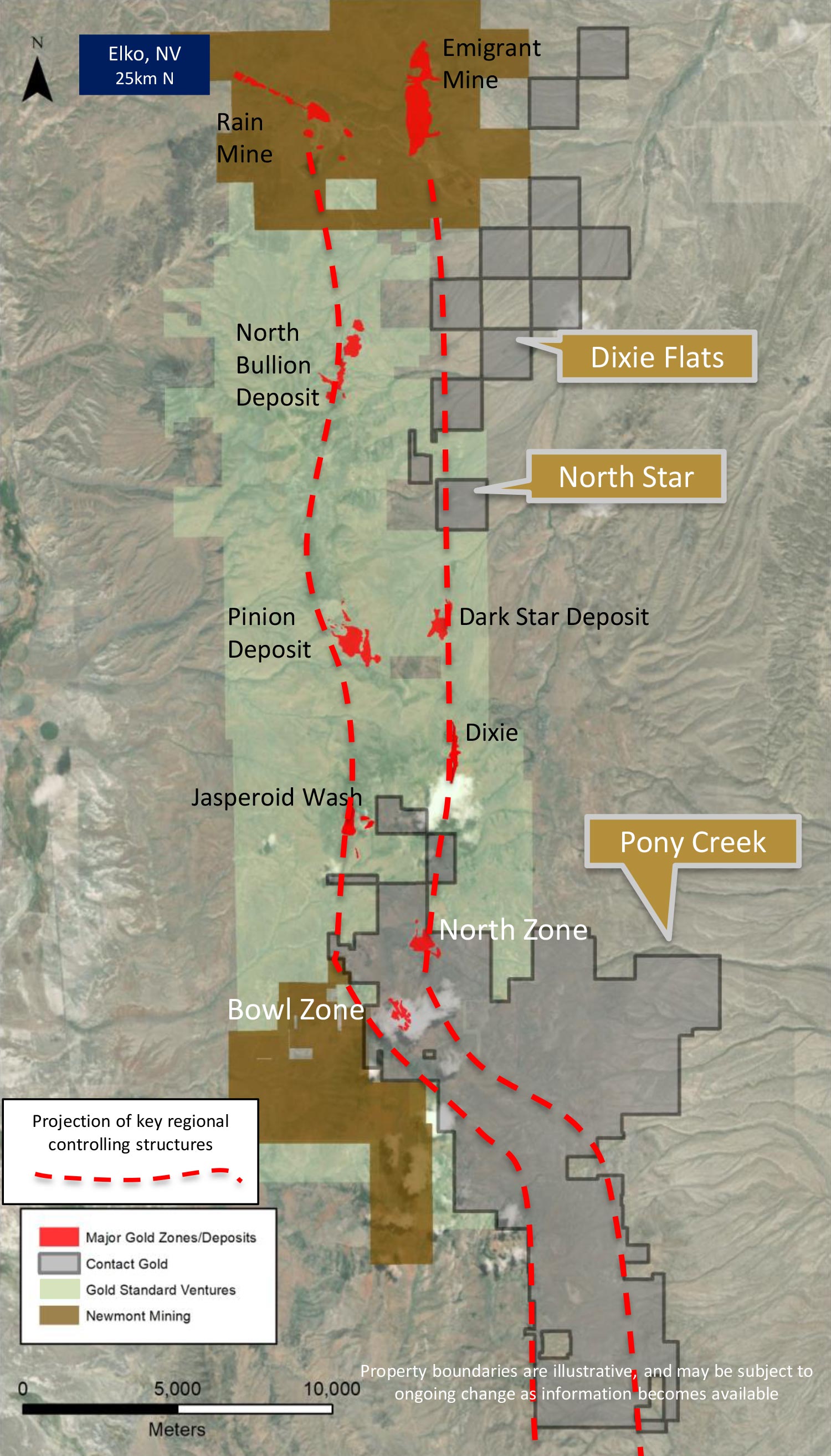 Pony Creek, Contact Gold’s flagship property, is located less than 30 kilometers south of the Emigrant gold mine, currently operated by Newmont Mining (NEM, NEM.TO). As you can see on the map, the Pony Creek claims are directly adjacent to the land package of Gold Standard Ventures (GSV, GSV.TO) which made the Dark Star gold discovery.
Pony Creek, Contact Gold’s flagship property, is located less than 30 kilometers south of the Emigrant gold mine, currently operated by Newmont Mining (NEM, NEM.TO). As you can see on the map, the Pony Creek claims are directly adjacent to the land package of Gold Standard Ventures (GSV, GSV.TO) which made the Dark Star gold discovery.
There is an apparent structurally mineralized corridor or trend in a north-south direction that has five established deposits (Emigrant, Rain, Dark Star, Pinion, North Bullion). Contact Gold’s Bowl zone (which hosts the 1.4Moz historical resource estimate) appears to be right on the same trend.
The Bowl zone was discovered by Newmont Mining just over 30 years ago, and was subsequently owned by Vista Gold which spun it off as part of the Allied Nevada transaction (Allied Nevada owned Vista’s entire Nevada portfolio). Allied Nevada went belly up, and Waterton Global Asset Management ended up with the assets.
Waterton’s natural resources department has an extensive portfolio with dozens of exploration, development and operating projects, but realized it cannot drill and explore all properties by themselves. After looking at several offers (and we would assume Gold Standard Ventures also had a look at the available claims), Waterton accepted an offer from Contact Gold which acquired the land package for a payment in cash, stock and preferred stock. This was Waterton’s preferred solution as it retained substantial upside potential compared to the other offers it received (which were predominantly made in cash and overvalued stock of exploration companies).
Contact Gold agreed to issue 18.55M shares, 11.111M preferred shares and make a C$7M cash payment to acquire the properties. This gave Waterton an initial 37% stake in Contact Gold, allowing it to participate in the exploration upside at Pony Creek (and the other properties). Not only was this stock component an important part of the consideration for Waterton, the latter was also impressed with the strong technical and management team at Contact Gold, and that really ‘sealed the deal’.
A large part of last year’s drill program was focusing on the Bowl zone of the Pony Creek project, where the historical resource is located. This zone was drilled with a core drill rig to confirm and verify the historical data on this zone, whilst a Reverse Circulation drill rig was used to expand the existing and known mineralized zones. Later in the season, Contact Gold directed a drill rig to the property’s North zone, which is located halfway between the Bowl zone and Gold Standard Ventures’ new Jasperoid Wash discovery.
The North Zone was originally discovered in the eighties, but it looks like Barrick Gold/Homestake were drilling too far up north and whilst their main interval of 43 meters at 0.47 g/t gold would be viable at today’s gold price thanks to the higher efficiency of heap leach techniques (compared to 30 years ago), there never was any follow up on that hole.
Contact Gold’s management team saw this as an opportunity and squeezed in 2,500 meters of drilling right before winter set in. A total of 11 holes were drilled at the North zone, and assay results of 44 meters at 0.34 g/t gold, 15 meters at 0.33 g/t gold and 14 meters at 0.32-0.33 g/t gold are encouraging results for a first drill program.
Virtually every hole drilled at Pony Creek as part of the 2017 exploration program has encountered anomalous gold values, and this did create some expectations for the 2018 exploration season…
Pony Creek
Contact Gold has been very successful this summer
Contact Gold started out to be a vehicle to update and upgrade the historic resource at the Bowl Zone of the Pony Creek project. But as Contact has enjoyed several exploration successes throughout the summer period, we feel it might make sense to split this section of our update report into the several zones that now have become the ‘hot spots’ for future exploration programs.
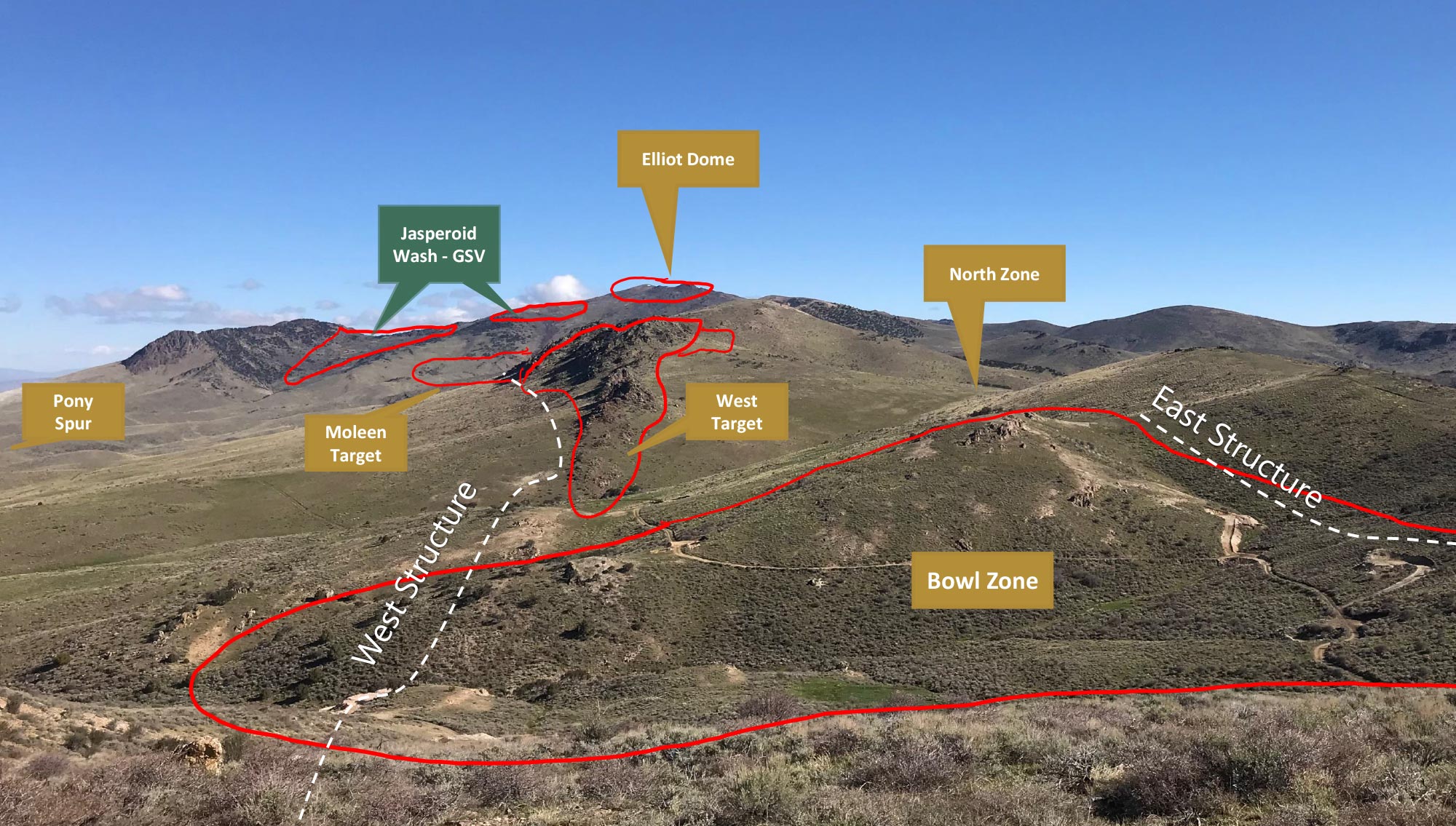
1. The Bowl Zone
The main focus of this year’s drill program is obviously to double-check the historical interpretation of the mineralization at the Bowl Zone, which hosts the historic resource containing 1.43 million ounces of gold at an excellent average grade of approximately 1.5 g/t.
And we dare to say Contact Gold was successful in increasing its level of confidence in the Bowl Zone. The first few holes of the 2018 drill season immediately returned high-grade oxide gold mineralization in new zones at Bowl. Intersecting in excess of 47 meters at 2.51 g/t gold and almost 93 meters at 1 g/t gold starting at respectively 87 meter and 50 meter down-hole are absolutely excellent results for oxide mineralization. On top of that, those holes were drilled on what appears to be the western edge of the Bowl Zone gold system, where very little drilling was conducted in the past. So these drill results confirm the wide-spread nature of the Bowl Zone mineralization.
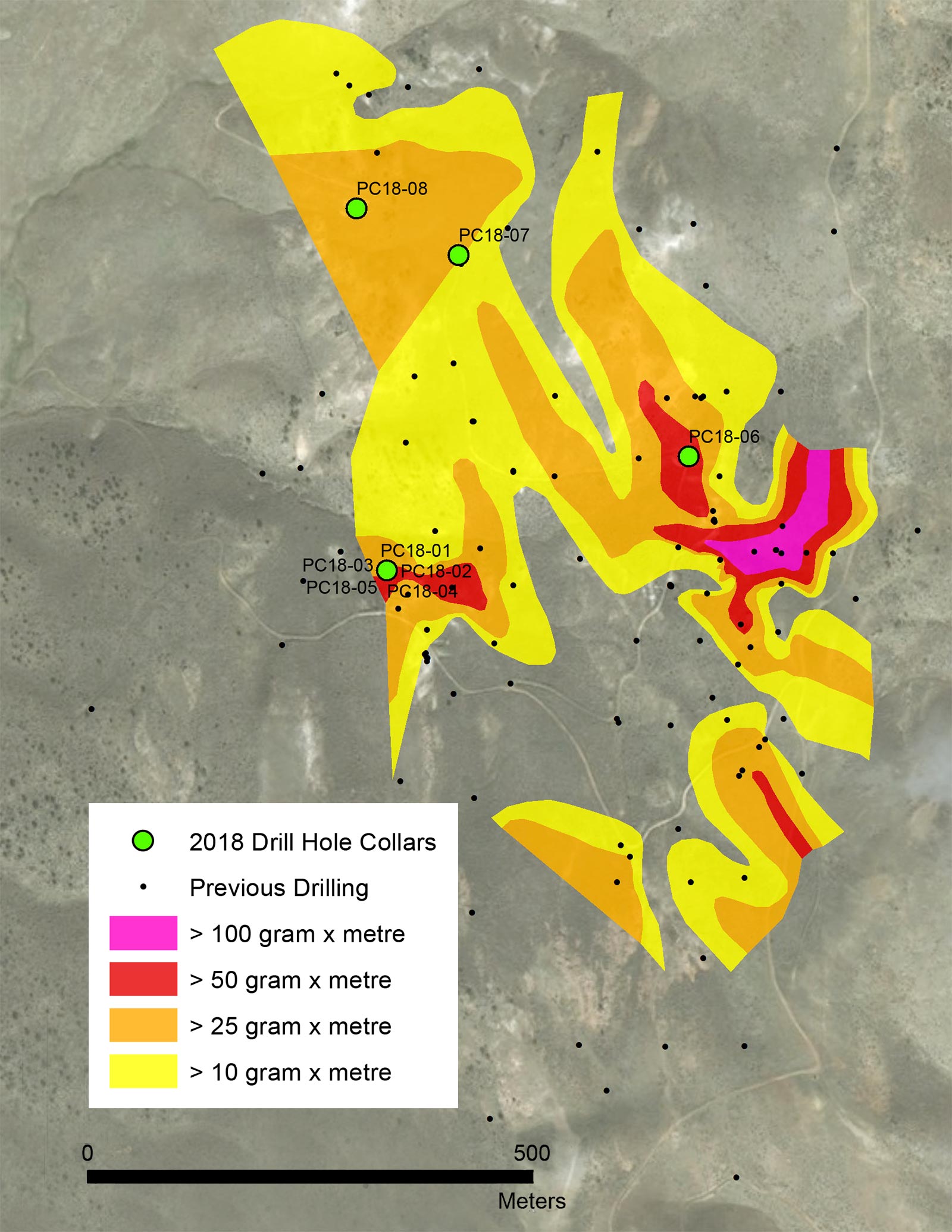
And Contact Gold continued to find more gold all over the Bowl Zone. Some of the intercepts were relatively deep, but we think the grade will make up for the strip ratio (we will assume an average strip ratio of 3:1 for the time being. Please note this is purely our own opinion/interpretation and not an official guidance from the company. A future resource update will provide us with a better ballpark number, and we will update our expectations accordingly). In any case, almost 50 meters containing 0.64 g/t gold as well as several 35 meter intervals containing respectively 0.34 g/t and 0.39 g/t gold are good results. On top of that, Contact Gold also hit some sulphide mineralization which returned 35 meters containing 2.42 g/t gold starting at a depth of 267 meters down-hole.
Whilst the oxide layer obviously is (and should be) the main focus right now, it’s good to see the sulphide zone underlying the oxides may provide an additional exploration target.
So why do we think the Pony Creek mineralization at 0.35-0.4 g/t may be viable? In May, Contact reported on the results of a first metallurgical test program on samples taken from the Bowl Zone. According to that test work, the average recovery rate of the gold was approximately 85-90%.

If we would use the lower end of that range, recovering 85% of 0.35 g/t material would result in 0.2975 g/t in recoverable gold, for a rock value of approximately US$12/t. That’s not a lot, but this shows why being able to use a heap leach processing method is an important part of why we like Contact Gold. According to a recent resource estimate provided by Corvus Gold, the estimated mining cost per tonne of rock is $1.40, while the processing and admin costs are estimated at $1.70/t. Using an average strip ratio of 3:1 for the Bowl Zone (note, these are just our own assumptions, and we will have to wait for the full NI43-101 report to establish a more precise strip ratio and operating cost estimate), the average cost to process one tonne of rock will be $7.30, resulting in a net margin of $4.70/t.
Again, let’s wait for a resource update before jumping to conclusions as Contact Gold may use more conservative parameters. But we are optimistic about the viability of the 0.35 g/t rock at the Bowl Zone.
Bowl Zone Drilling
2. The West Target
In August, Contact Gold released the first assay results from the four drill holes that were completed on the so-called West Target. This Target is located approximately 1 kilometer North-Northwest from the main Bowl Zone, and is immediately adjacent to Gold Standard Ventures’ (GSV, GSV.TO) land package and its Jasperoid Wash zone.
With 3 meters at 0.21 g/t, 12 meters at 0.18 g/t and 33.5 meters at 0.42 g/t, Contact Gold’s initial drill results are very encouraging. Whilst the first two intervals are relatively low-grade, the 33.5 meters of 0.42 g/t (which includes 4.5 meters of 1.1 g/t) could be seen as a discovery hole. It’s also interesting to see that specific hole (hole 18, that we highlighted on the image) is still a few hundred meters from the company’s claim borders, so it will be interesting to see if Contact Gold could ‘build tonnage’ there.
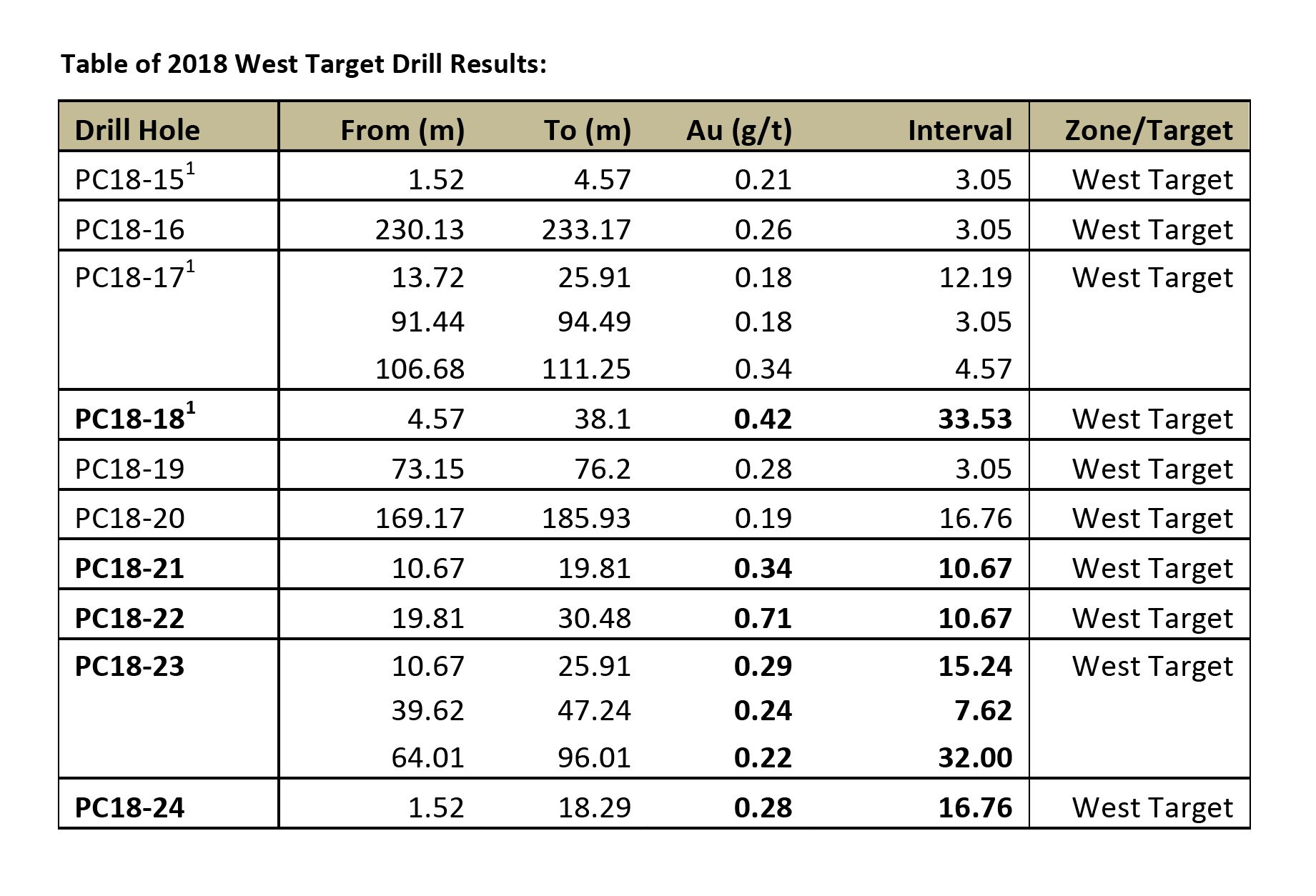
The main takeaway from those first holes was the gold discovery in between the known Bowl Zone and Gold Standard Ventures’ Jasperoid Wash target, where Gold Standard Ventures had published excellent drill results with for instance 23 meters at 0.76 g/t gold, almost 81 meters at 0.53 g/t gold and 52 meters at 0.58 g/t gold.
Needless to say discovering gold at the West Target was an excellent start of the exploration efforts focusing on that zone, but the holes that were subsequently drilled have expanded the strike length of the West Zone to in excess of a kilometer as all 10 holes (a 100% success rate) successfully intersected gold mineralization.
The West Target is characterized by several faults (in Northwest and Northeast trends) intersecting each other. According to Contact’s technical team, this appears to be very similar to the geological structures controlling the gold mineralization at both the Bowl Zone and very likely Gold Standard Ventures’ Jasperoid Wash Zone as well. The gold mineralization at the West Target appears to be part of the Pennsylvanian-Permian host rock, and this layer appears to be the same one hosting the North Dark Star deposit on Gold Standard’s land package.
3. New Discoveries
As Contact Gold drill-tested several zones in the Greater Pony Creek area, it encountered several new gold zones. Approximately one kilometer west of the West Target, Contact discovered an entirely new gold zone, now called ‘Pony Spur’. Contact has released the assay results of just 3 holes, but with 21.3 meters containing 0.17 g/t gold, 19.8 meters of 0.21 g/t gold and 27.4 meters containing 0.19 g/t gold, it’s already clear there’s a widespread ‘blanket of gold’ at the Pony Spur zone. 0.2 g/t gold isn’t viable, but these initial results could vector Contact Gold towards economic-grade mineralization.
And more recently, Contact Gold announced it has been developing a new Carlin-type gold target at Pony Creek as it has been advancing the so-called Elliott Dome zone, which is located immediately adjacent to GSV’s Jasperoid Wash zone. Exploration companies sometimes use the word ‘adjacent to’ too often, but in Contact Gold’s case, it definitely isn’t an exaggeration.
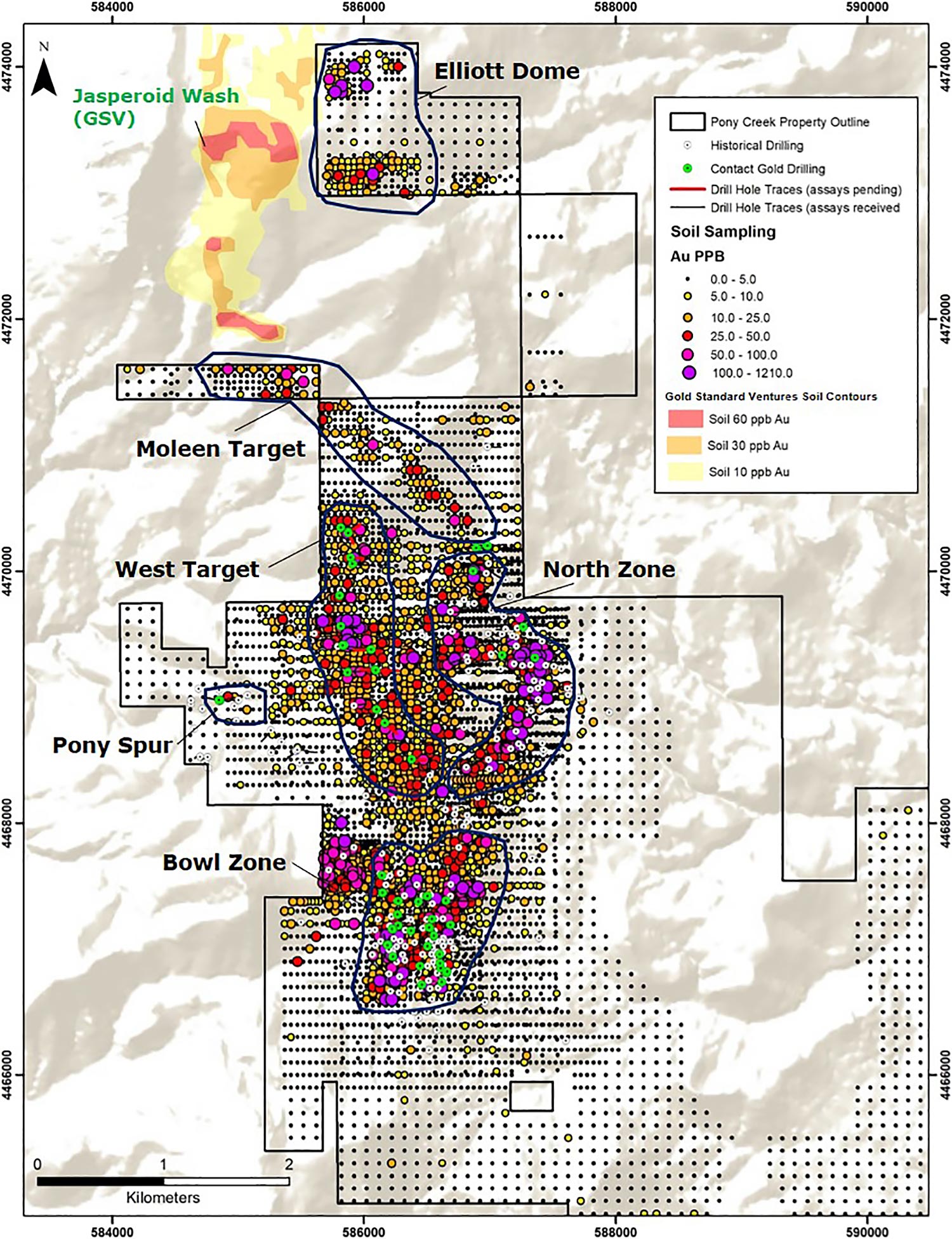
As you can see on the previous image, the soil samples taken as part of Contact Gold’s exploration program are located just meters away from Gold Standard’s Jasperoid Wash discovery. The total footprint of Contact Gold’s soil anomaly is approximately 1,200 by 700 meters for a total surface area of 84 hectares.
This target hasn’t been drilled yet, but it shows how important Contact Gold’s exploration model is. The Elliott Dome was discovered through a combination of surface mapping, a sampling program (rock and soil) as well as a CSAMT survey provided by ‘a neighboring company’ (which sounds like Gold Standard Ventures performed these surveys). This is the exact same methodology Contact also used to develop the West Target and we can’t wait to see this zone being drill-tested.
What are the next steps?
Contact Gold still has to report on 16 holes, of which the majority was aiming to continue to drill-test the West Target in large step-outs to determine the total size of the gold mineralization. Keep in mind the West Target has a strike length of approximately 2 kilometers (based on the gold-in-soil anomaly). Additionally, some holes will test the rhyolite/sediment contact zones to try to detect higher-grade gold mineralization.
A few holes of the 16 that still have to be released were infill holes at the Bowl Zone. The results and interpretation of these holes will be important for Contact as they will provide useful information to update the historic resource to NI43-101 standards. We would expect Contact to be in a position to publish a compliant resource estimate in the first half of 2019. It’s still too early to guesstimate the total size of the resource, but we would be happy with in excess of 1 million ounces at an economic grade.
After seeing the results of this year’s successful exploration program, we are now more than ever convinced Pony Creek and Gold Standard Ventures’ mineralized zones should be seen as one huge gold-bearing system. And that’s very likely exactly how the senior producers are looking at this Nevada play. We think it’s not a coincidence Goldcorp owns a sizeable stake in both Gold Standard Ventures and Contact Gold, as combining both entities would make a lot of sense from the viewpoint of a large producer (and Goldcorp has actually been increasing its position in Gold Standard Ventures). Of course, this is purely speculation from our part, but it sounds like a viable working theory.
How did Contact Gold spend its money so far?
We are anxiously awaiting for Contact Gold to publish its financial results for the first nine months of the financial year as that will provide us with an updated cash position and expense report. But even when looking at the operating expenses in the first half of the year, it’s clear Contact will be spending the majority of its cash on the ground.
Keep in mind a half-year report doesn’t necessarily provide a good way to fine-tune the full-year expenses as Contact’s drill season is predominantly centered around the summer months. This means we would expect the ratio of exploration expenditures versus total expenses to increase. But as mentioned before, even in the first half of the year (with Q1 as a very ‘exploration light quarter’) a large part of the expenses was spent on Pony Creek:
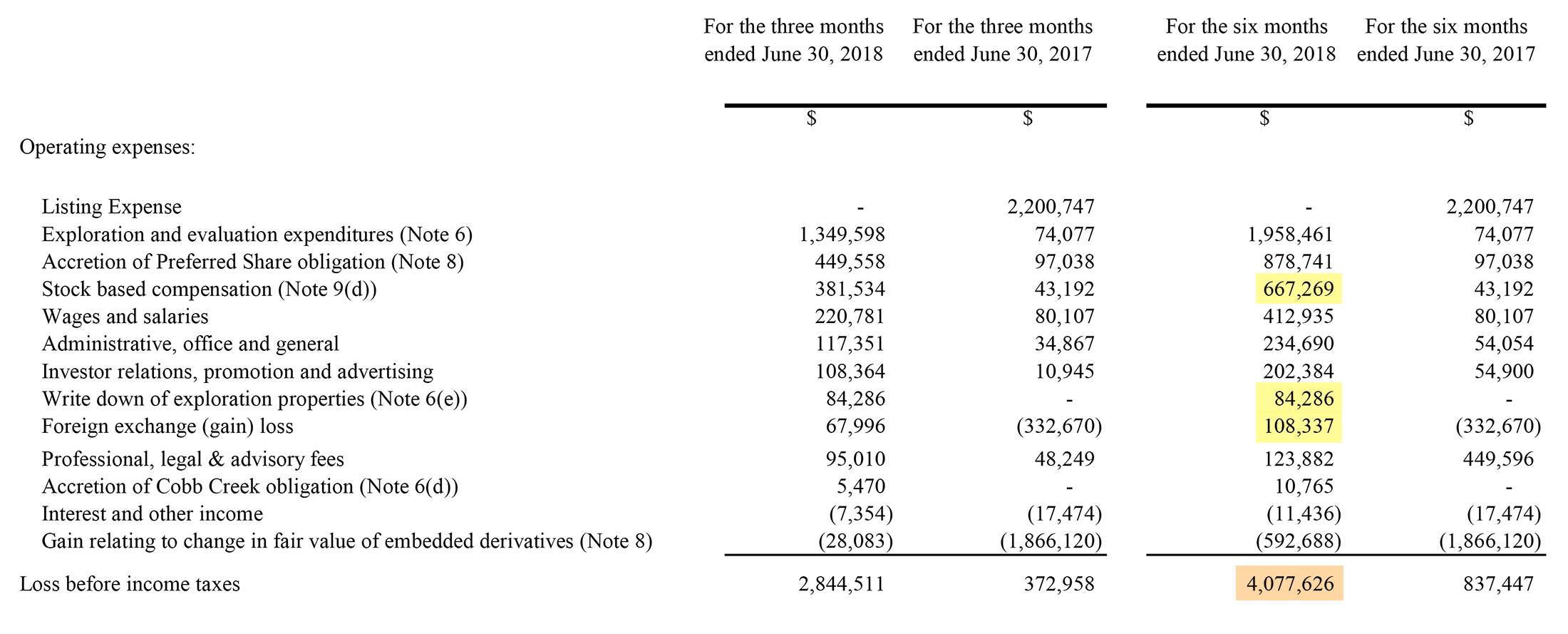
The total amount of expenses were C$4.1M, which includes a C$0.6M benefit from a change in the fair value of the derivatives (related to the preferred share rights). So on an adjusted basis, the total amount of expenses incurred in the first half of the year would be approximately C$4.67M. But this amount still includes some non-cash expenses which we have highlighted in yellow. After taking these elements into consideration as well, Contact’s cash expenditures came in at approximately C$3.81M. We did include the accrued interest payments on the preferred shares as a cash expense (although the accrued dividend payments will only have to be paid at the very end), as these expenses should be seen as a deferred cash expense. Excluding this accrual would have resulted in a net cash expense of approximately C$3M.
This means that in the first half of the year, approximately 51% of the expenses were effectively spent on the project. This might seem low, but keep in mind there’s a seasonal effect and we expect the full-year result to reflect a (much) higher percentage. Also, excluding the deferred dividend payments from the equation would increase the ratio of cash spent on the properties to 67%, and that’s a high percentage in this sector. We still expect this percentage to increase after taking the expenses of the summer exploration program into consideration.
Conclusion
We feel Contact Gold has made a lot of progress this year as not only was it able to chase and confirm the gold zones that were discovered by historical drilling, it also drill-tested the edges of the main Bowl Zone system where the previous operators hadn’t conducted a lot of drilling yet.
On top of that, Contact Gold has discovered several new zones that are worth following up on. The West Target and Elliott Dome discoveries could provide a whole new perspective as it now looks Contact Gold’s projects could actually be part of a very large gold system that includes Gold Standard Ventures’ Jasperoid Wash zone.
We expect the company to release more drill results throughout the next few months, as Contact still has to release the assay results of 16 more holes. Its technical team will then be able to analyze the data to design an exploration program for 2019. Meanwhile, it will also be interesting to see if Contact Gold would already feel sufficiently comfortable to publish an updated resource estimate on the Pony Creek project. We think Contact should ‘go for it’, even if the compliant resource would be smaller than the historic resource at this time, as it would help the company to provide the market with something ‘tangible’ to justify a higher valuation.
Disclosure: Contact Gold is a sponsor of the website. The author has a long position in Contact Gold.










